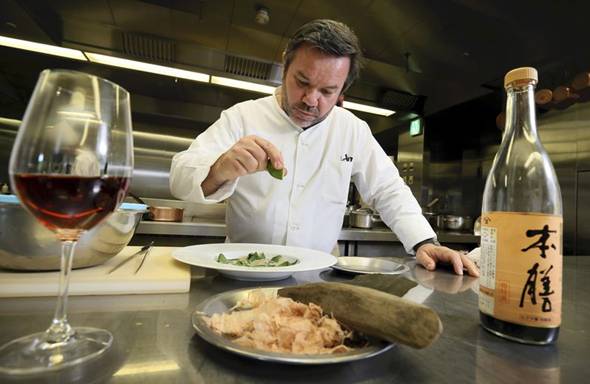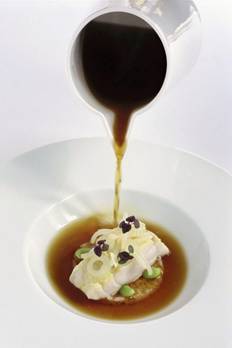White wine and dashi, a match made in heaven
Posted on November 15, 2013 On The Japan News by The Yomiuri Shimbun
http://the-japan-news.com/news/article/0000771011

The Yomiuri Shimbun
Michel Troisgros cooks using dashi made from kombu and bonito shavings for sauce
at his restaurant in Shinjuku Ward, Tokyo
The Yomiuri Shimbun
The popularity of washoku traditional Japanese cuisine—from everyday dishes to expensive kaiseki ryori—has spread to big cities like New York and Paris, influencing their residents’ daily diet. Not only that, washoku is expected to be added to the UNESCO Intangible Cultural Heritage list in December. The Yomiuri Shimbun is reporting on the cuisine through the eyes and palates of non-Japanese. The following is the second installment of a four-part series on washoku.
PARIS—Michelin three-star chef Michel Troisgros is hooked on dashi soup stock.
“Dashi is a healthy ingredient that makes a clear soup, and most of all, the afterglow of its palatability lasts a long time,” he said.
His famous recipe using dashi soup stock is called “Bouillon de cabillaud au riz Koshihikari.” For this dish, he mixes white wine with a dashi stock extracted from kombu seaweed and dried bonito shavings, reduces the liquid and seasons it with soy sauce and ginger before pouring the sauce over steamed codfish served on a bed of rice.
“There are customers who want seconds of only this dish,” he said.
 In another dashi recipe, he adds cream to reduced dashi and soy sauce to make a special sauce.
In another dashi recipe, he adds cream to reduced dashi and soy sauce to make a special sauce.
The France-based Troisgros supervises the restaurant Cuisine[s] Michel Troisgros in Shinjuku Ward, Tokyo.
“French bouillon has to be simmered for a long time, but Japanese dashi can be cooked quickly as long as I have high-quality kombu and bonito shavings. Dashi has a smokey aroma that gives depth to the taste of the whole dish. Dashi is a great ingredient with a lot of potential,” he said.
Contributor
A Michel Troisgros dish
French chefs began showing interest in washoku in the 1970s. Amid the popularity of sushi, they began using ingredients unique to Japan, such as soy sauce and wasabi, for their recipes. Around the same time, French cuisine trends shifted from emphasizing rich, buttery sauces to utilizing the taste of ingredients that have lighter flavors. Kaiseki ryori, with its beautiful presentation, was another influence.
“Due to the synergistic effect of kombu and bonito shavings, Japanese dashi has a stronger umami flavor than other soup stocks from the West or China,” said Kumiko Ninomiya of the Tokyo-based nonprofit organization Umami Information Center. “In washoku, dashi itself increases umami, and it’s possible to adjust the taste without using much salt or fat.”
Introducing dashi abroad
Outside Japan, there are many non-Japanese chefs who work at washoku restaurants, and it took some time for people overseas to appreciate the delicate flavor of dashi, which is indispensable for washoku.
Japanese chefs have held seminars in Japan and abroad to help more people understand how washoku should taste. Recently, notable chefs overseas have begun to study dashi, and the word is gradually becoming used more in the West.
Last month, a group of chefs from Belgium came to Japan to learn about dashi in Tokyo and Kyoto.
Osaka-based Tsuji Culinary Institute has a tie-up with a Thai college and has taught Japanese cuisine there since last year.
“What we hope to do [with the Thai students] is enrich their understanding of making dashi and umami,” said Haruaki Matsuoka, who teaches at the school. “I want my students to learn the basics thoroughly and spread washoku’s appeal over the world.”
Dashi has been thought to be difficult for non-Japanese people to understand. However, the growing global popularity of washoku has helped dashi to be used in dishes from other countries.
Original Article: The Japan Times by Yomiuri Shimbun
http://the-japan-news.com/news/article/0000771011
